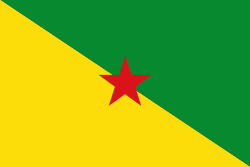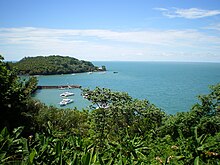This article may need to be rewritten to comply with Wikipedia's quality standards. (September 2022) |
French Guiana
| |
|---|---|
| Territorial Collectivity of French Guiana Collectivité territoriale de Guyane (French) | |
| Motto(s): "Liberté, Égalité, Fraternité" (French) (English: "Liberty, Equality, Fraternity") "Fert Aurum Industria" (Latin) (English: "Work Creates Abundance") | |
| Anthem: La Marseillaise ("The Marseillaise") Chant du départ ("Song of Departure") [nb 1] | |
 | |
 | |
| Coordinates: 3°56′02″N 53°07′33″W / 3.9339°N 53.1258°W | |
| Country | |
| Prefecture | Cayenne |
| Departments | 1 (every overseas region consists of a department in itself) |
| Government | |
| • Prefect | Antoine Poussier[1] |
| • President of the Assembly | Gabriel Serville (Guyane Kontré pour avancer) |
| • Legislature | Assembly of French Guiana |
| Area | |
• Total | 84,000 km2 (32,433 sq mi) |
| • Land | 83,534 km2 (32,253 sq mi) |
| • Water | 466 km2 (180 sq mi) |
| • Rank | 2nd region and 1st department |
| Population (January 2024)[5] | |
• Total | 295,385 |
| • Density | 3.5/km2 (9.1/sq mi) |
| Demonym(s) | (French) Guianan (French) Guianese |
| GDP | |
| • Total (2022) | €4.562 billion |
| • Per capita | €16,600 |
| Time zone | UTC-3:00 (GFT) |
| ISO 3166 code | |
| Currency | Euro (€) (EUR) |
| Website | Territorial Collectivity Prefecture |
 | |
French Guiana[a] is an overseas department and region of France located on the northern coast of South America in the Guianas and the West Indies. Bordered by Suriname to the west and Brazil to the east and south, French Guiana covers a total area of 84,000 km2 (32,000 sq mi)[2][3][7] and a land area of 83,534 km2 (32,253 sq mi).[3]As of January 2024, it is home to approximately 295,385 people. [5]

French Guiana is the second-largest region in France, being approximately one-seventh the size of Metropolitan France, and the largest outermost region within the European Union. It has a very low population density, with only 3.6 inhabitants per square kilometre (9.3/sq mi). About half of its residents live in its capital, Cayenne. Approximately 98.9% of French Guiana is covered by forests,[8] much of it primeval rainforest. The Guiana Amazonian Park, the largest national park in the EU[9] covers 41% of French Guiana's territory.
Since December 2015, both the region and department have been ruled by a single assembly within the framework of a single territorial collectivity, the French Guiana Territorial Collectivity.[b] This assembly, the French Guiana Assembly,[c] replaced the former regional and departmental council, which were dissolved. The French Guiana Assembly is in charge of regional and departmental government. Its president is Gabriel Serville.

Fully integrated in the French Republic since 1946, French Guiana is a part of the European Union, and its official currency is the euro. A large part of French Guiana's economy depends on jobs and businesses associated with the presence of the Guiana Space Centre, now the European Space Agency's primary launch site near the equator. As elsewhere in France, the official language is standard French, but each ethnic community has its own language, of which French Guianese Creole, a French-based creole language, is the most widely spoken. French Guiana is the only territory on the continental mainland of the Americas that is still under the sovereignty of a European state.
The border between French Guiana and Brazil is the longest land border that France shares with another country, as well as one of only two borders which France shares with non-European states, the other being the border with Suriname in the west.
Cite error: There are <ref group=nb> tags on this page, but the references will not show without a {{reflist|group=nb}} template (see the help page).
- ^ "Le Préfet - Représentant de l'État, du gouvernement et de l'Europe". Les services de l'État en Guyane (in French). Retrieved 31 May 2024.
- ^ a b Christiane Taubira (28 April 2009). "FICHE QUESTION". Questions National Assembly of France (in French). Retrieved 27 November 2021.
- ^ a b c "Population by sex, annual rate of population increase, surface area and density" (PDF). United Nations. 2013. p. 5. Retrieved 27 November 2021.
- ^ "French Guiana country profile". BBC News. 22 October 2023. Retrieved 22 October 2023.
- ^ a b "Estimation de population par région, sexe et grande classe d'âge – Années 1975 à 2024" (in French). Retrieved 17 January 2024.
- ^ "EU regions by GDP, Eurostat". Retrieved 18 September 2023.
- ^ "French Guiana country profile". BBC News. 22 October 2023. Retrieved 22 October 2023.
- ^ "FAOSTAT – Land Use". Food and Agriculture Organization. Retrieved 3 February 2019.
- ^ "Parc amazonien de Guyane, le plus vaste Parc national de France et de l'Union européenne". Guiana Amazonian Park. Retrieved 3 February 2019.
Cite error: There are <ref group=lower-alpha> tags or {{efn}} templates on this page, but the references will not show without a {{reflist|group=lower-alpha}} template or {{notelist}} template (see the help page).

